Is St. James Really Buried in Santiago de Compostela, Spain?
As you head down a curve of the busy San Pedro street, you catch your first view of the twin bell towers of the cathedral of Santiago de Compostela—and you catch your breath. Petite hatchbacks rattle across the cobblestone as your feet seem drawn farther down the path, although that might just be gravity pulling you downhill toward the old zone. You cinch up your backpack’s sternum strap for the final approach of this multiple-night pilgrimage.
For not the first time on your Camino, you lose your sense of direction as you enter Santiago’s old town: granite flagstones at your feet, stone-and-graying-plaster houses on either side, and overcast skies above disorient you—yet your eyes eventually lock on to a spray-painted yellow arrow on the side of a building. Once you’re back on autopilot, you start to reflect on why you started this crazy, 70-mile-plus hike in the first place.
Maybe you hiked from Sarria farther inland as a cheap and healthy way of experiencing the beauty of the Galician countryside: foggy forest mornings perfumed by bright, fresh eucalyptus…farms and ranches dotted by tiny corn granaries on stilts and monumental stone crosses…the inscrutable dialect of pensioners at the bar that you can barely make sense of only after a shot of herb-infused moonshine…or the simple pleasure of a picnic of mild cheese spread over moist country bread, eaten in the cool shade of an 800-year-old parish church.
Maybe you hiked for reasons you still don’t fully understand, drawn by the mysterious call of the Way of St. James after watching a movie, reading a memoir, listening to music, or hearing a friend share stories of her blister- and sunburn-ridden Camino last summer. It’s hard to explain, but it just feels right to rise with the sun, pack your bag, wake up over espresso and a croissant, and simply walk with a purpose, day after day.
Maybe you hiked because you needed to get away from “the real world” and have some time alone to figure things out after graduating college, ending a relationship, shifting careers, or mourning a loved one. Putting one foot in front of the other for hours each day can be meditative, and the time you’ve spent as a pilgrim has helped you get some clarity and direction.
Maybe you hiked because it’s a Holy Year and there’s the promise of a plenary indulgence at the end of the road, the promise that you’ll be absolved of the guilt you’ve been carrying around for the way you’ve been treating your family and co-workers or that bad habit you can’t seem to kick. Not having to worry about spending time in Purgatory is a plus, too.
Or maybe you hiked because you’ve been suffering from an ailment for years, and either you can’t afford proper treatments, or various prescribed cures simply haven’t worked. You’re still holding out hope for a miracle, however: maybe, just maybe, praying at the shrine of the Apostle St. James will finally heal this sickness of yours.
The bouncy, blaring notes of a bagpipe force you to focus back on the trail—and here you are, at the northern entrance to the cathedral. You step inside, cross yourself with holy water from the stoup, and slide into a back-row pew. It’s time to rest, at last. You breathe deeply of incense leftover from the human-sized thurible hanging from the ceiling that almost masks the body odor of fellow pilgrims. Candlelight reflects off the gaudy high altar—and there he is, Santiago, St. James.
You hobble across the church as fast as your blistered feet will take you and line up with pilgrims, tourists, and faithful visitors. You step up the smooth stone stairs and embrace this statue of the saint whose fatherly gaze has greeted pilgrims since medieval times.
Beaming, you now step back down from the baldachin and immediately turn left to descend a few more steps into the crypt. This is it: this is where St. James is buried. You’re surrounded by penitent pilgrims whispering prayers in this poorly lit room, and your eyes are directed toward a bright silver sarcophagus at the end of a narrow chute.
Here, at the ultimate end of your pilgrimage, you wonder: is it really him in there?
The Galician capital, Santiago, was founded in the early Middle Ages on the belief that the city guarded the relics of St. James or Santiago—one of Jesus Christ’s closest disciples and the first of the 12 apostles to be executed for his faith.
The discovery of his purported remains was a shot in the arm for the nascent Christian kingdoms of far northern Spain that were trying to “re-”conquer the Iberian peninsula from the powerful Muslim caliphate to the south, as they granted special status to mere noblemen searching for legitimacy. Santiago would, according to legend, appear in battles against the Muslims as the frontlines moved south. Today, he is the patron saint of all Spaniards.
The finding of his supposed bones also inspired a pilgrimage phenomenon—the Camino de Santiago or Way of St. James—that would draw penitents from across western Europe and make Compostela the third-holiest site in Christendom after Rome and Jerusalem.
But was all of this just one big lie?
Without knowing the true, deep-down intent of the hermit who stumbled upon the remains, the bishop who confirmed them as belonging to St. James, the Asturian king who was the first pilgrim to Compostela, and countless other religious and secular leaders who encouraged the veneration of St. James, it’s impossible for us to call this whole situation a “lie.”
We’ll never know for sure whether there was some kind of goal to deceive other people into thinking the body of an apostle who was murdered in Palestine had appeared in a distant backwater of western Europe…or whether it was just a misunderstanding by pre-scientific folks whose minds were primed to associate said skeleton with one of the Church’s pre-eminent saints.
Still, looking into how this legend began, the historical context surrounding it, and what really happened makes for an interesting discussion. Let’s dive in.
His mother, Salome, was present when Jesus died on the cross and was one of the first witnesses to the empty tomb. Expecting Jesus’ growing movement to violently kick the Romans out of Palestine, Salome asked Jesus to have her two sons sit on the right and left sides of his throne when he established his kingdom. After Jesus ascended into heaven, however, James took on the mantle of an apostle and preached the Good News. He was ultimately beheaded in Jerusalem as the first martyred apostle.
In summary, St. James was both a prominent biblical character and a significant early Christian leader: a saint that any city or kingdom would love to have as their advocate.
Mary is also said to have appeared to James in Muxía on the northwestern coast of Galicia. Carried to Gallaecia on a sailboat made of stone, Mary showed up at this rocky outcrop to comfort and strengthen James as he wandered across what would have felt like the ends of the Earth.
After James was executed, his own disciples retrieved his body and placed it in a stone boat that mystically made its way across the Mediterranean. It landed in Iria Flavia (modern-day Padrón), where some of James’ followers collected his remains and took them inland for burial.
These disciples asked the local Queen Lupa for assistance, but she deviously directed them to a mountain called Pico Sacro, where a hostile dragon and two wild bulls lay in wait. Although these menacing creatures nearly killed them, they relented when the disciples made the sign of the cross, which slew the dragon and tamed the bulls. When they returned to Lupa, the queen and her vassals converted to Christianity.
These disciples continued on, letting the oxen lead the way until they stopped at the summit of Mt. Libredón, the nucleus of today’s Compostela. Here they buried the apostle’s body, where it lay hidden and forgotten for almost 800 years.
Re-entering the historical record, it was the year 814 when the hermit Paio claimed to see lights glimmering in the oak groves to the north of the Church of San Fiz de Solovio. Investigating further, he stumbled upon an old Roman burial ground (a compositum, where the name Compostela comes from) that happened to contain the relics of the Apostle St. James. Paio notified Bishop Teodomiro of Iria Flavia, who quickly arrived and confirmed that the bones Paio had discovered belonged to Santiago himself.
It wasn’t long before King Alfonso II of Asturias made the trek from Oviedo, his capital, west to Compostela to pay homage to this saint. Alfonso would be the very first pilgrim on the Way of St. James.
Now, is there any proof at all for these traditions that multiple cities across Spain associate with St. James? In short, no. Simply put, the entire historical record dating up to the year 600 doesn’t support the presence of James in Spain at all.
In addition, St. Paul, who lived and preached at the same time as James, mentions in his letter to the Romans that he planned to visit the imperial capital on his way to Spain (15.23–24). Yet he also emphasizes that he always tries to preach the gospel in places that haven’t heard of it yet, because he doesn’t want to build “on someone else’s foundation” (v. 20). Why would Paul express a desire to journey to Spain if his fellow apostle, James, had already evangelized the peninsula and established Christian communities there?
There also isn’t any evidence that Christians who lived before James’ remains were discovered believed that he was buried in Compostela. Even authors in the 700s who did assert that James had preached in the peninsula affirmed that he was buried where he had been beheaded: in Jerusalem.
I should also bring up Priscillian, a fourth-century bishop of Ávila who the emperor executed on charges of sorcery after the church declared him a heretic. Priscillian was a proponent of asceticism, so much so that he was accused of Gnostic Manichaeism, a dualistic movement that claimed there was a battle between light and darkness that pitted the soul and spiritual things against the body and the natural world. His followers brought his body from Trier, then the imperial capital in western Germany, back to Spain, where he was treated as a martyr and where his teachings soon grew in popularity. Priscillianism continued to bother orthodox church leaders well into the 600s, especially in Galicia.
Why bring up Priscillian in a blog post about Santiago? Many have speculated that the remains now venerated in Compostela actually belong to Priscillian. Historian Richard Fletcher summarizes the argument:
St. James is not buried in Santiago de Compostela.
But someone certainly is.
Is it simply one Hispano-Roman (among many in the cemetery wealthy enough to be buried in a stone vault) that the hermit Paio happened to stumble upon that one starry night?
Is it some nameless saint, whose tomb was honored for centuries before encroaching chestnut trees and oaks hid it away?
Or is it Priscillian, whom the church and the state executed but whose followers continued to thrive in this remote corner of Spain for hundreds of years after his death? These possibilities, to me, seem more likely than not.
Even the late-medieval Castilian King Alfonso X “the Wise,” who reigned 400 years after the remains in question were found, wrote the following about relics in the Middle Ages:
As I said at the beginning of this post, there’s no way for me to attribute malicious intent to those who discovered Santiago and call them liars. The whole situation may not be true, but it wasn’t a lie.
Perhaps Paio, dedicated to a hermit’s life of solitude, prayer, and meditation on the Scriptures and the lives of the saints, truly experienced some kind of a vision that led him to this cemetery from ancient times, validating his decision to withdraw from society to the woods and devote himself to God.
Perhaps Bishop Teodomiro was so convinced by Paio’s religious experience and the evidence of the bones themselves that he ruled out the possibility that the hermit was mistaken.
Perhaps both were primed to accept these relics as authentic, eager to forget that up until recently a heresy had thrived in northwest Spain, eager to assert a renewed Christian presence on a peninsula that was still mostly governed by Muslims.
Perhaps the king of Asturias credulously embraced the discovery of the relics one of Christianity’s foremost saints because he needed a patron for the kingdom he was trying to build out of the rubble of the Visigoths, whom invaders from North Africa had toppled.
Perhaps he was looking for a sign that the kingdom of Asturias, far from the center of the Christian world—and civilization—was favored by God and blessed by the remains of one of Jesus’ earliest followers.
Perhaps. We’ll never know for sure, but what we do know is this: the remains of a famous first-century Christian from Palestine aren’t those guarded in this cathedral on the far western edge of the Mediterranean world.
For not the first time on your Camino, you lose your sense of direction as you enter Santiago’s old town: granite flagstones at your feet, stone-and-graying-plaster houses on either side, and overcast skies above disorient you—yet your eyes eventually lock on to a spray-painted yellow arrow on the side of a building. Once you’re back on autopilot, you start to reflect on why you started this crazy, 70-mile-plus hike in the first place.
 |
| Rúa de San Pedro, Santiago de Compostela |
Maybe you hiked from Sarria farther inland as a cheap and healthy way of experiencing the beauty of the Galician countryside: foggy forest mornings perfumed by bright, fresh eucalyptus…farms and ranches dotted by tiny corn granaries on stilts and monumental stone crosses…the inscrutable dialect of pensioners at the bar that you can barely make sense of only after a shot of herb-infused moonshine…or the simple pleasure of a picnic of mild cheese spread over moist country bread, eaten in the cool shade of an 800-year-old parish church.
Maybe you hiked for reasons you still don’t fully understand, drawn by the mysterious call of the Way of St. James after watching a movie, reading a memoir, listening to music, or hearing a friend share stories of her blister- and sunburn-ridden Camino last summer. It’s hard to explain, but it just feels right to rise with the sun, pack your bag, wake up over espresso and a croissant, and simply walk with a purpose, day after day.
Maybe you hiked because you needed to get away from “the real world” and have some time alone to figure things out after graduating college, ending a relationship, shifting careers, or mourning a loved one. Putting one foot in front of the other for hours each day can be meditative, and the time you’ve spent as a pilgrim has helped you get some clarity and direction.
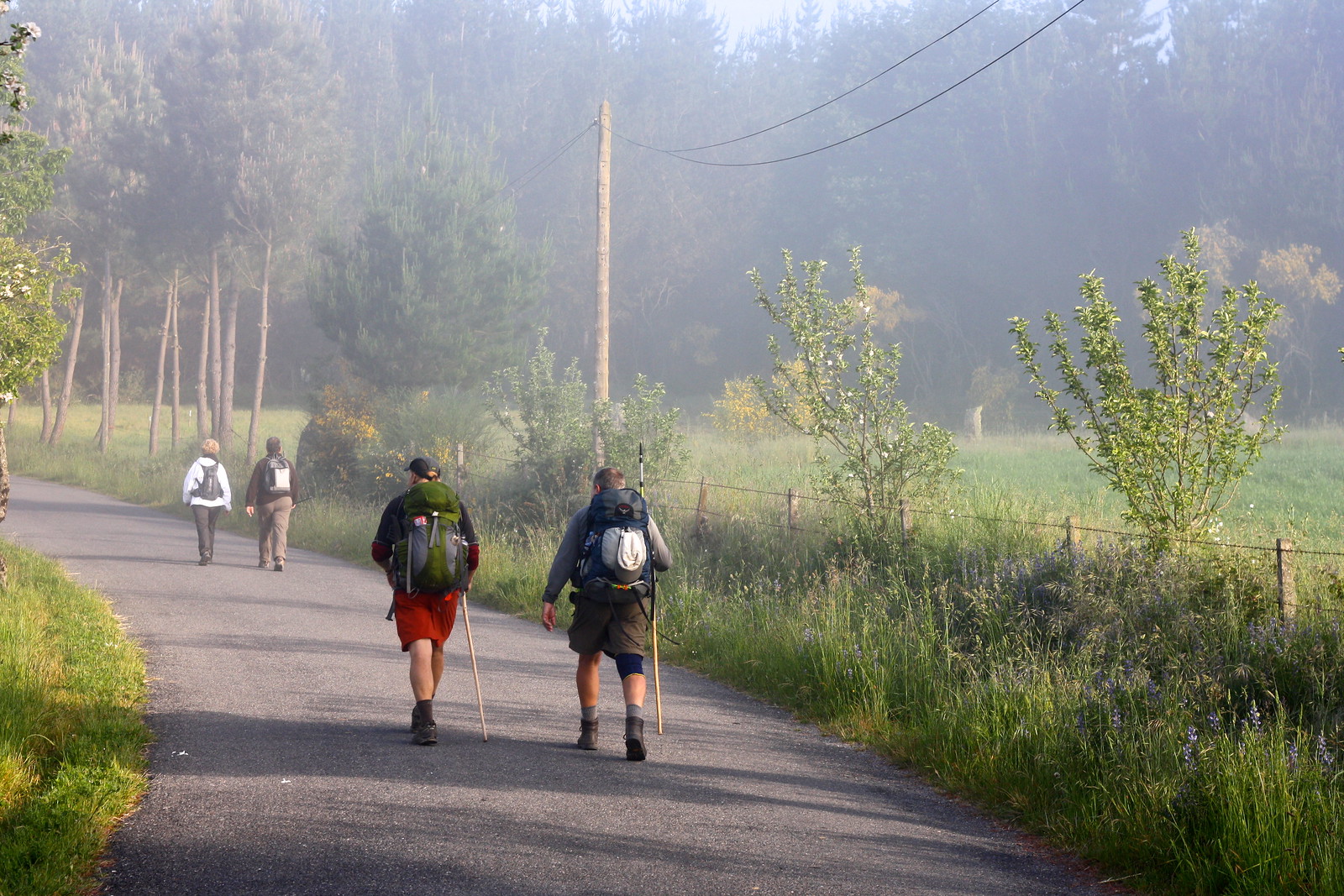 |
| Hiking the camino francés |
Maybe you hiked because it’s a Holy Year and there’s the promise of a plenary indulgence at the end of the road, the promise that you’ll be absolved of the guilt you’ve been carrying around for the way you’ve been treating your family and co-workers or that bad habit you can’t seem to kick. Not having to worry about spending time in Purgatory is a plus, too.
Or maybe you hiked because you’ve been suffering from an ailment for years, and either you can’t afford proper treatments, or various prescribed cures simply haven’t worked. You’re still holding out hope for a miracle, however: maybe, just maybe, praying at the shrine of the Apostle St. James will finally heal this sickness of yours.
The bouncy, blaring notes of a bagpipe force you to focus back on the trail—and here you are, at the northern entrance to the cathedral. You step inside, cross yourself with holy water from the stoup, and slide into a back-row pew. It’s time to rest, at last. You breathe deeply of incense leftover from the human-sized thurible hanging from the ceiling that almost masks the body odor of fellow pilgrims. Candlelight reflects off the gaudy high altar—and there he is, Santiago, St. James.
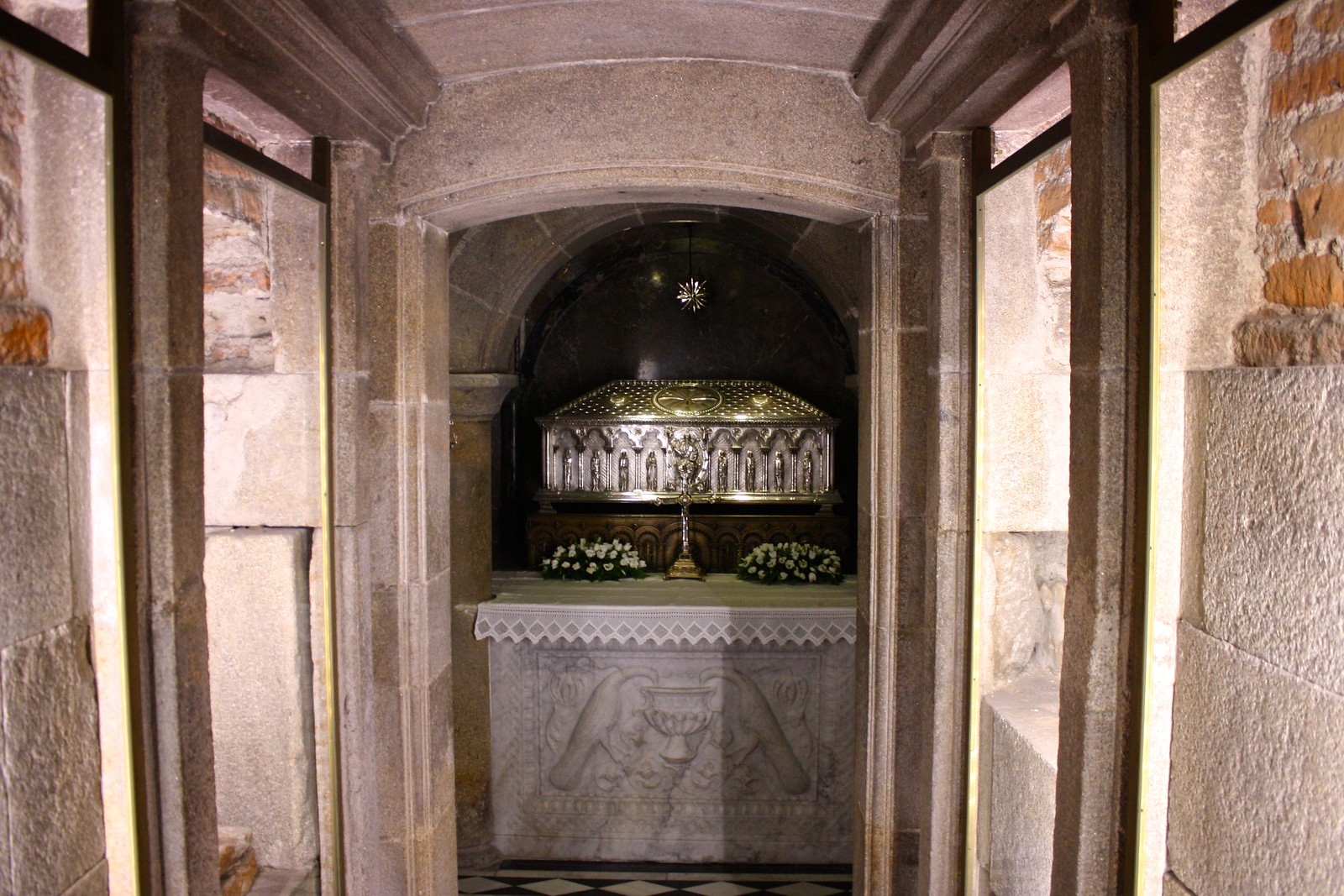 |
| The sepulcher that holds the shrine of Santiago |
You hobble across the church as fast as your blistered feet will take you and line up with pilgrims, tourists, and faithful visitors. You step up the smooth stone stairs and embrace this statue of the saint whose fatherly gaze has greeted pilgrims since medieval times.
Beaming, you now step back down from the baldachin and immediately turn left to descend a few more steps into the crypt. This is it: this is where St. James is buried. You’re surrounded by penitent pilgrims whispering prayers in this poorly lit room, and your eyes are directed toward a bright silver sarcophagus at the end of a narrow chute.
Here, at the ultimate end of your pilgrimage, you wonder: is it really him in there?
Is that really St. James beneath Santiago’s cathedral?
I first sat down to write this post on the feast day of St. James, which reminded me of the special place he holds in the hearts of those who live in Santiago de Compostela—not to mention Galicians in northwestern Spain and Spaniards as a whole, all of whom call the Apostle St. James their patron saint.The Galician capital, Santiago, was founded in the early Middle Ages on the belief that the city guarded the relics of St. James or Santiago—one of Jesus Christ’s closest disciples and the first of the 12 apostles to be executed for his faith.
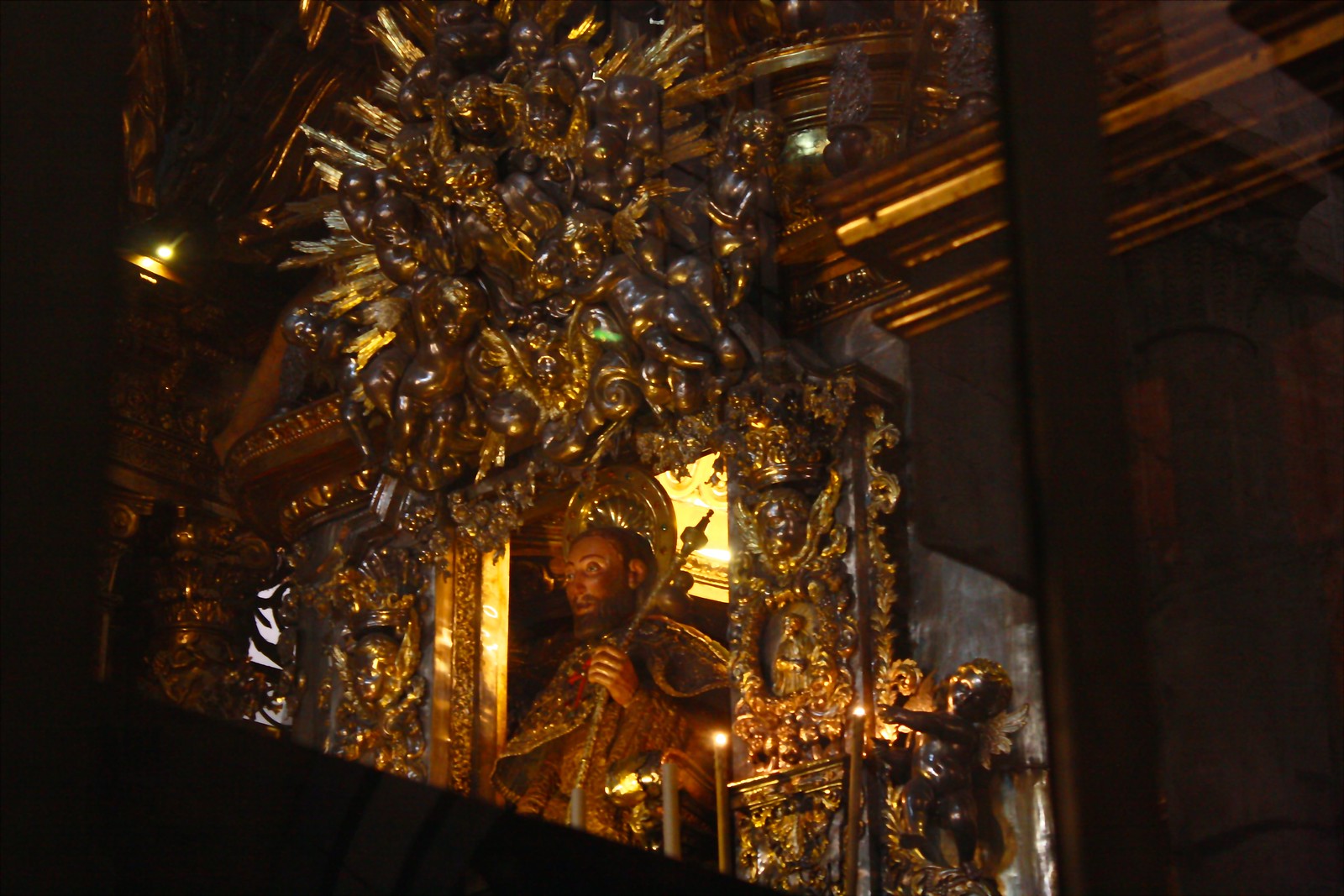 |
| Statue of the apostle in the cathedral |
The discovery of his purported remains was a shot in the arm for the nascent Christian kingdoms of far northern Spain that were trying to “re-”conquer the Iberian peninsula from the powerful Muslim caliphate to the south, as they granted special status to mere noblemen searching for legitimacy. Santiago would, according to legend, appear in battles against the Muslims as the frontlines moved south. Today, he is the patron saint of all Spaniards.
The finding of his supposed bones also inspired a pilgrimage phenomenon—the Camino de Santiago or Way of St. James—that would draw penitents from across western Europe and make Compostela the third-holiest site in Christendom after Rome and Jerusalem.
But was all of this just one big lie?
Without knowing the true, deep-down intent of the hermit who stumbled upon the remains, the bishop who confirmed them as belonging to St. James, the Asturian king who was the first pilgrim to Compostela, and countless other religious and secular leaders who encouraged the veneration of St. James, it’s impossible for us to call this whole situation a “lie.”
We’ll never know for sure whether there was some kind of goal to deceive other people into thinking the body of an apostle who was murdered in Palestine had appeared in a distant backwater of western Europe…or whether it was just a misunderstanding by pre-scientific folks whose minds were primed to associate said skeleton with one of the Church’s pre-eminent saints.
Still, looking into how this legend began, the historical context surrounding it, and what really happened makes for an interesting discussion. Let’s dive in.
What we know about St. James from the Bible
According to the accounts in the biblical Gospels (the books of Matthew, Mark, Luke, and John), St. James was one of Jesus’ closest disciples. With his brother John, he fished in the Sea of Galilee with their father, Zebedee, until Jesus called them to follow him and be “fishers of men” instead. James and John would soon join Peter in Jesus’ inner circle of confidants. All three were invited to the Transfiguration—the event when Jesus was revealed in all his glory as the Son of God on a mountaintop—and they all privately joined Jesus in prayer in the Garden of Gethsemane the night before he was crucified.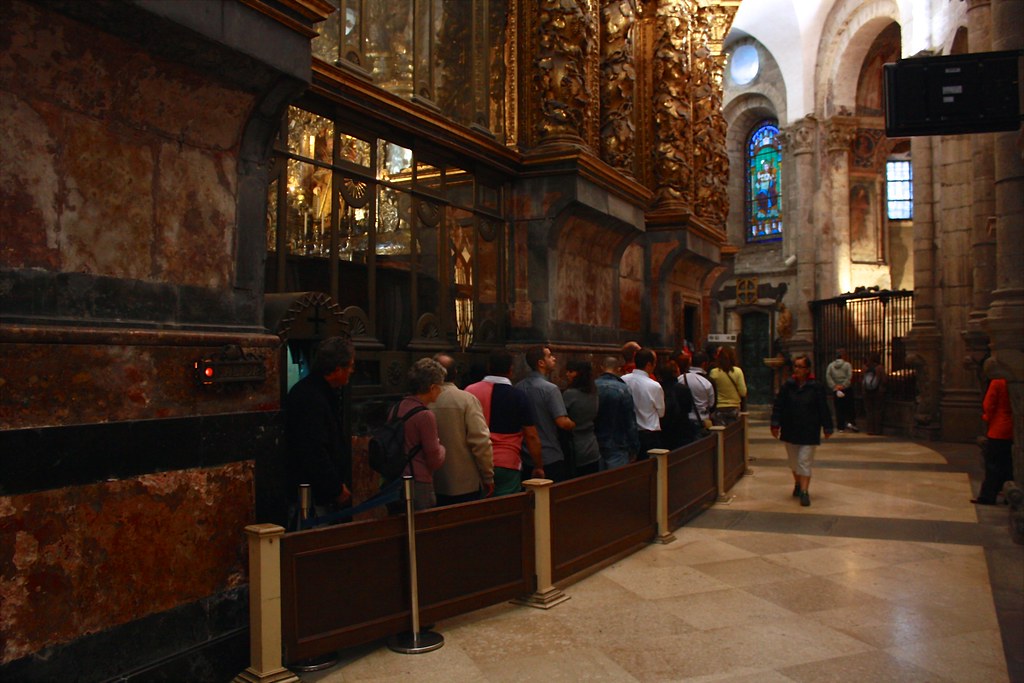 |
| The line to hug the statue of St. James |
His mother, Salome, was present when Jesus died on the cross and was one of the first witnesses to the empty tomb. Expecting Jesus’ growing movement to violently kick the Romans out of Palestine, Salome asked Jesus to have her two sons sit on the right and left sides of his throne when he established his kingdom. After Jesus ascended into heaven, however, James took on the mantle of an apostle and preached the Good News. He was ultimately beheaded in Jerusalem as the first martyred apostle.
In summary, St. James was both a prominent biblical character and a significant early Christian leader: a saint that any city or kingdom would love to have as their advocate.
Recapping the legends surrounding St. James
In the early Middle Ages, the belief arose that St. James visited Roman Hispania, where he traveled across the peninsula and preached the Gospel before returning to Jerusalem. During his time in Spain, he stopped in Caesaraugusta (a.k.a. Zaragoza) and tried to evangelize the city’s residents, apparently with little success. The Virgin Mary—even while still alive in Palestine—bodily appeared to James to encourage him on his journey, leaving behind a marble votive column with a command to build a chapel there in her honor.Mary is also said to have appeared to James in Muxía on the northwestern coast of Galicia. Carried to Gallaecia on a sailboat made of stone, Mary showed up at this rocky outcrop to comfort and strengthen James as he wandered across what would have felt like the ends of the Earth.
After James was executed, his own disciples retrieved his body and placed it in a stone boat that mystically made its way across the Mediterranean. It landed in Iria Flavia (modern-day Padrón), where some of James’ followers collected his remains and took them inland for burial.
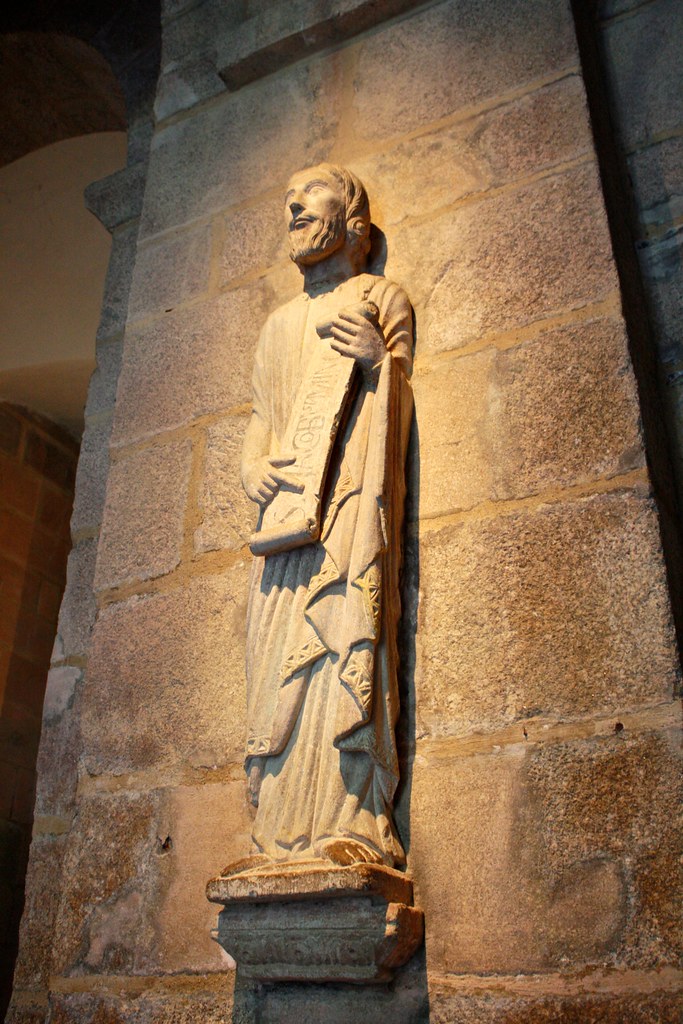 |
| Statue of St. James in the cathedral crypt |
These disciples asked the local Queen Lupa for assistance, but she deviously directed them to a mountain called Pico Sacro, where a hostile dragon and two wild bulls lay in wait. Although these menacing creatures nearly killed them, they relented when the disciples made the sign of the cross, which slew the dragon and tamed the bulls. When they returned to Lupa, the queen and her vassals converted to Christianity.
These disciples continued on, letting the oxen lead the way until they stopped at the summit of Mt. Libredón, the nucleus of today’s Compostela. Here they buried the apostle’s body, where it lay hidden and forgotten for almost 800 years.
Re-entering the historical record, it was the year 814 when the hermit Paio claimed to see lights glimmering in the oak groves to the north of the Church of San Fiz de Solovio. Investigating further, he stumbled upon an old Roman burial ground (a compositum, where the name Compostela comes from) that happened to contain the relics of the Apostle St. James. Paio notified Bishop Teodomiro of Iria Flavia, who quickly arrived and confirmed that the bones Paio had discovered belonged to Santiago himself.
It wasn’t long before King Alfonso II of Asturias made the trek from Oviedo, his capital, west to Compostela to pay homage to this saint. Alfonso would be the very first pilgrim on the Way of St. James.
What we know from history
In this section I rely heavily on medieval historian Richard Fletcher’s work, Saint James’s Catapult: The Life and Times of Diego Gelmírez of Santiago de Compostela (Oxford: Clarendon, 1984).Now, is there any proof at all for these traditions that multiple cities across Spain associate with St. James? In short, no. Simply put, the entire historical record dating up to the year 600 doesn’t support the presence of James in Spain at all.
In addition, St. Paul, who lived and preached at the same time as James, mentions in his letter to the Romans that he planned to visit the imperial capital on his way to Spain (15.23–24). Yet he also emphasizes that he always tries to preach the gospel in places that haven’t heard of it yet, because he doesn’t want to build “on someone else’s foundation” (v. 20). Why would Paul express a desire to journey to Spain if his fellow apostle, James, had already evangelized the peninsula and established Christian communities there?
 |
| Statue of St. James in the Pórtico da Gloria |
There also isn’t any evidence that Christians who lived before James’ remains were discovered believed that he was buried in Compostela. Even authors in the 700s who did assert that James had preached in the peninsula affirmed that he was buried where he had been beheaded: in Jerusalem.
I should also bring up Priscillian, a fourth-century bishop of Ávila who the emperor executed on charges of sorcery after the church declared him a heretic. Priscillian was a proponent of asceticism, so much so that he was accused of Gnostic Manichaeism, a dualistic movement that claimed there was a battle between light and darkness that pitted the soul and spiritual things against the body and the natural world. His followers brought his body from Trier, then the imperial capital in western Germany, back to Spain, where he was treated as a martyr and where his teachings soon grew in popularity. Priscillianism continued to bother orthodox church leaders well into the 600s, especially in Galicia.
Why bring up Priscillian in a blog post about Santiago? Many have speculated that the remains now venerated in Compostela actually belong to Priscillian. Historian Richard Fletcher summarizes the argument:
“What is tolerably clear is that an early Christian holy place existed at Compostela and that it was attracting devotion until at least the early seventh century. From there to the time of bishop Theodemir [who authenticated the remains as St. James’] is a mere two hundred years. It is not impossible that the memory of such a cult [of Priscillian], or even manifestations of it that have left no archaeological trace, should have persisted through this intervening period” (p. 60).
Wrapping things up
So, we’ve gone over the biblical accounts of the life of the apostle James, the legends and traditions that have been handed down around the saint, and what the historical record does and doesn’t say about him. What kind of conclusions can we start to draw?St. James is not buried in Santiago de Compostela.
But someone certainly is.
 |
| Burial grounds beneath the cathedral |
Is it simply one Hispano-Roman (among many in the cemetery wealthy enough to be buried in a stone vault) that the hermit Paio happened to stumble upon that one starry night?
Is it some nameless saint, whose tomb was honored for centuries before encroaching chestnut trees and oaks hid it away?
Or is it Priscillian, whom the church and the state executed but whose followers continued to thrive in this remote corner of Spain for hundreds of years after his death? These possibilities, to me, seem more likely than not.
Even the late-medieval Castilian King Alfonso X “the Wise,” who reigned 400 years after the remains in question were found, wrote the following about relics in the Middle Ages:
“Some men fraudulently discover or build altars in fields or in towns, saying that there are relics of certain saints in those places and pretending that they perform miracles, and, for this reason, people from many places are induced to go there as on a pilgrimage, in order to take something away from them; and there are others who influenced by dreams or empty phantoms which appear to them, erect altars and pretend to discover them in the above named localities.” —From the Siete Partidas, quoted in Carl Sagan, The Demon-Haunted World (New York: Ballantine, 1996), p. 144It would be insincere to connect Alfonso’s first example—those who swindle others into believing they’ve encountered the miracle-working relics of a saint—with the Camino de Santiago, but his second—those who’ve convinced themselves they’ve found the remains of saint—would seem to fit the stars-flickering-in-the-trees mystical experience that the hermit Paio had that one night, 1,200 years ago.
As I said at the beginning of this post, there’s no way for me to attribute malicious intent to those who discovered Santiago and call them liars. The whole situation may not be true, but it wasn’t a lie.
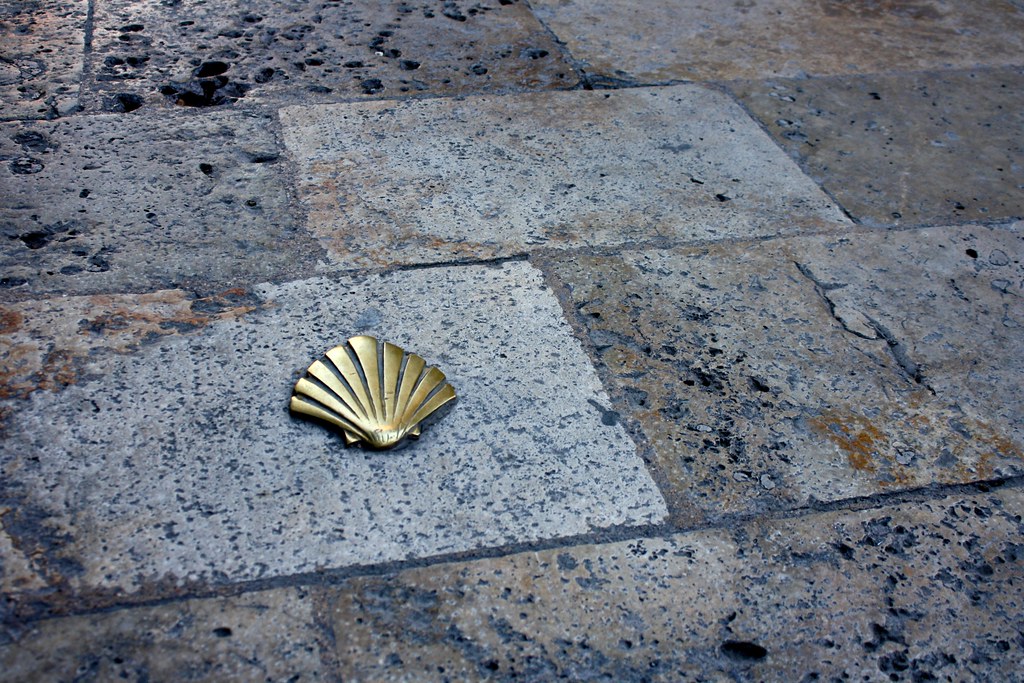 |
| Waymark on the Aragonese Way |
Perhaps Paio, dedicated to a hermit’s life of solitude, prayer, and meditation on the Scriptures and the lives of the saints, truly experienced some kind of a vision that led him to this cemetery from ancient times, validating his decision to withdraw from society to the woods and devote himself to God.
Perhaps Bishop Teodomiro was so convinced by Paio’s religious experience and the evidence of the bones themselves that he ruled out the possibility that the hermit was mistaken.
Perhaps both were primed to accept these relics as authentic, eager to forget that up until recently a heresy had thrived in northwest Spain, eager to assert a renewed Christian presence on a peninsula that was still mostly governed by Muslims.
Perhaps the king of Asturias credulously embraced the discovery of the relics one of Christianity’s foremost saints because he needed a patron for the kingdom he was trying to build out of the rubble of the Visigoths, whom invaders from North Africa had toppled.
Perhaps he was looking for a sign that the kingdom of Asturias, far from the center of the Christian world—and civilization—was favored by God and blessed by the remains of one of Jesus’ earliest followers.
Perhaps. We’ll never know for sure, but what we do know is this: the remains of a famous first-century Christian from Palestine aren’t those guarded in this cathedral on the far western edge of the Mediterranean world.